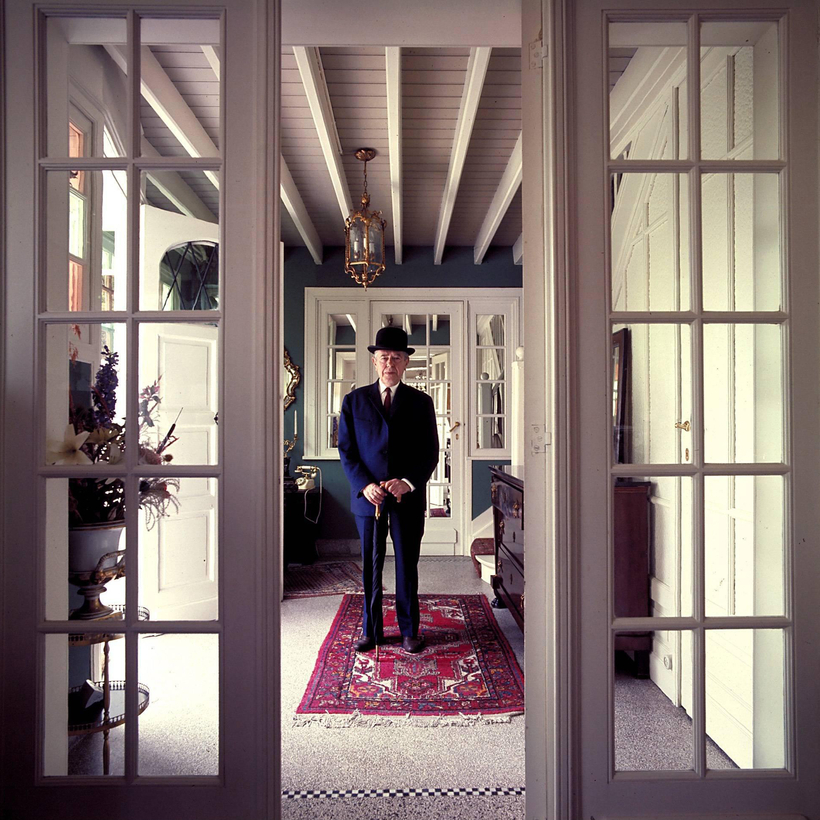If artistic genius summons the image of a wild-eyed dervish stalking a paint-splattered studio, then René Magritte ignored the memo. The Belgian surrealist didn’t even have a studio, or at least not one that he did his painting in. His easel was set up in a corner of his suburban living room, where he worked silently in suit, tie, and slippers. Much of the time he was accompanied by his wife, Georgette, sitting just as quietly.
Such outward signs of bourgeois respectability do not appear to recommend Magritte as a biographer’s ideal subject. But Alex Danchev, who died in 2016 as he was about to finish this sinuous book (the final chapter was written by the art historian Sarah Whitfield), has uncovered a life that was by turns quirky, controversial, and tinged by tragedy. Danchev describes Magritte, born in 1898, as “the dream merchant of our time,” and he goes a long way to explaining why, by going back to his mother’s disappearance when he was 13.

Magritte’s rascally father had been in the habit of locking his mother in the house at night because of her suicidal tendencies. One night she got free, and 17 days later her body was fished out of the River Sambre, near their home in Lessines. Forever after, Magritte was reluctant to talk about what happened, but it is supposed that he heard about his mother’s body being found with her nightdress pulled up over her head.
It is not precisely clear when Magritte picked up a paintbrush for the first time, because he kept it a secret from his rowdy group of friends. But it appears to have been not long afterward, certainly when he was in his early teens. “Magritte’s art is full of the visible that is hidden,” Danchev notes. The same can also be said later of the man himself, with his gnomic utterances and carefully curated persona.

“His public life was a kind of performance art—a model for Gilbert and George—the suit, the bowler hat, the unvarying regime,” Danchev writes, “always the same dog (a Pomeranian), always the same name (Loulou or Jackie), always the same walk, immortalized in a Paul Simon song.” What all this hid was a highly angst-ridden individual who struggled for years to make a proper living from selling his art.
Desperate Measures
The paintings that we know so well today, such as The Treachery of Images (1929) or Rape (1945), were most often scorned and ridiculed when they first appeared. The lack of commercial success led Magritte to take some desperate measures to put bread on the table, or “butter on his spinach,” as he liked to say. The shady activities he embarked upon during World War II included forging paintings by renowned artists—such as Picasso, de Chirico (the artist whose work Magritte most admired), and, at one point, Titian.
The forgeries only became public knowledge in 1983, some 16 years after Magritte’s death, at the age of 68, when his partner in crime, the Belgian poet Marcel Mariën, published his autobiography. Mariën revealed that Magritte had even considered becoming a full-time copyist and giving up his own art altogether.
Magritte’s fortunes were finally transformed in the 1950s, when Greek collector Alexander Iolas, who owned galleries in New York and Europe, took up Margritte’s work and championed it.

Danchev, who also wrote estimable biographies of Georges Braque and Paul Cézanne, makes a compelling case for Magritte as a much more political painter than he is often given credit for. “The tendency to perceive Magritte’s work as entertainment is a category error,” he writes, “confining and in the end belittling.” He cites Magritte’s 1935 painting Le Modèle Rouge, which depicts a pair of laced leather boots whose front portions are actually bare human feet, as a charge against capitalist exploitation.
Despite Magritte’s middle-class demeanor, he longed for a proletarian revolution that would transform the world. In a 1938 speech entitled “Lifeline”—one of the rare public occasions when he spoke openly about his art—Magritte described Surrealism as “revolutionary because it is implacably opposed to all the bourgeois ideological values that keep the world in the appalling state it is today.”
This book leaves no doubt that the image Magritte maintained of himself as a regular citizen living a quiet life in a nondescript Brussels neighborhood was indeed performance art of the highest order. “Magritte was a maverick,” Danchev writes. “His weapon of choice was the paintbrush. If bourgeois order was nothing but disorder, then it could be subverted, that is, reimagined.”
Tobias Grey is a Gloucestershire, U.K.–based writer and book critic

